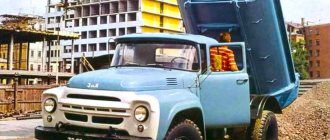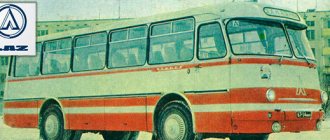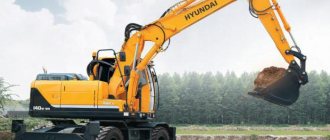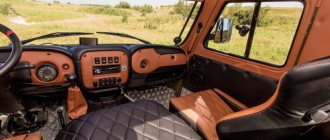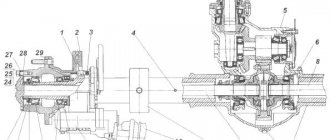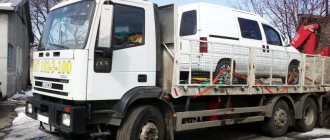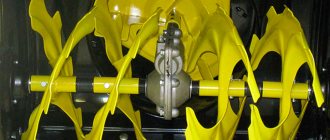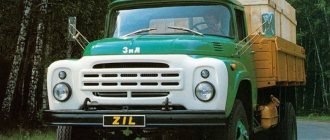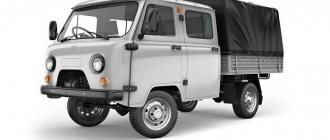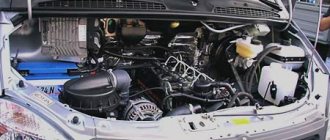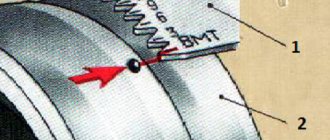The active development of the Russian industry for the mass production of cars for various purposes began during the years of the USSR. Some models turned out to be outright failures, but those production models also appeared that were later deservedly called true legends of the domestic automotive industry. One of them certainly includes the ZIL-130 truck.
History of the creation of ZIL-130
The predecessor of the ZIL-130 is considered to be the ZIL-164, which was essentially just a slightly modernized copy of the far from flawless ZIS-150 truck.
A fundamentally new truck was developed under the leadership of chief designer A. M. Krieger and engineer G. A. Fest. And E.V. Sabo and the chief artist of the plant T.P. Kiseleva worked on the external appearance.
There is an opinion that the appearance of the car was copied from one of the Ford models. And it cannot be argued that no borrowing actually took place.
Externally, the 130 really strongly resembles trucks such as the International R series, Dodge C series and Ford F series. However, we are definitely not talking about 100% plagiarism. Factory specialists simply followed fashion trends of the time. Even now, many modern cars can sometimes be distinguished from each other only by their logo.
A test sample of the new truck was released in 1956. The process of running-in and improvements lasted for several more years. They decided to install a water-cooled V-shaped eight-cylinder engine designed for mass production, easy to manufacture, but quite technologically advanced and reliable on the car.
A ready-made new model for the plant, which currently exists only in projects
By the mid-1960s, there was an acute shortage of trucks with a carrying capacity of over eight tons in the Soviet Union. Cargo turnover within the country was growing, and it was already very difficult for existing automobile plants to keep up with this growth.
The country needed a new mass-produced truck - powerful and versatile, with a diesel engine. We needed a simple and reliable machine, unpretentious in operation, on the basis of which many modifications could be developed: from a flatbed truck to a long-haul truck tractor and a chassis for installing special equipment. The new ZIL-170 became just such a truck.
When developing it, the designers also took into account the experience of foreign manufacturers. For example, it is known that among the samples purchased abroad for review was the American International COF-220 truck, mass-produced from 1962 to 1966.
Why was this necessary? This fact is connected with the personality of the chief designer of the Likhachev Plant. Anatoly Mavrikievich Krieger was well acquainted with the developments and model range of the American company International Harvester, and the venerable specialist liked the overseas truck. Krieger had used trucks before, when working on the ZiS-150.
The KamAZ plant - the Kama auto giant - was built by the whole country, starting in the summer of 1969. A new basic model for it was already tested in Moscow: the prototype ZIL-170 was ready already in 1968!
Yaroslavl engine builders developed a family of diesel power units (KAMAZ-740) for future KamAZ trucks. Dump bodies were designed at the Minsk Automobile Plant and the Mytishchi Machine-Building Plant. The Balashov State Design Bureau for trailers and the Odessa Automobile Assembly Plant designed trailers and semi-trailers. The BelAZ-5410 truck tractor turned into the KamAZ-5410 - the famous one in Zhodino also participated in this process.
Start of serial production
The machine was launched into production in 1964 at the Likhachev plant. There, the process of modernization, aimed specifically at mass production of cars, had just completed. Just 10 years later, the millionth truck rolled off the factory assembly line. And by 1994, when the decision was made to discontinue production of this model, there were already almost 4 million cars produced.
The vehicle's carrying capacity was about 5.5 tons, but the robust design of the frame and rear axle made it possible to overload the vehicle without much damage to performance characteristics. The maximum speed when unloaded was 90 km/h. True, gasoline consumption reached almost 40 liters per hundred kilometers. But in the 60s and 70s in the USSR they did not pay attention to fuel economy.
The truck could start from 2nd and even 3rd gear. First gear was used mainly on steep climbs and when driving along rugged terrain.
One of the distinctive features of the ZIL-130 was its signature color. The vast majority of trucks of that time were produced with the ability to quickly transfer the civilian cargo fleet to the needs of the armed forces. And therefore their color was predominantly green. The cabin of this car was sky blue with a snow-white front part.
There are many theories as to why it was painted in these particular colors. The most common opinion is that there is a banal excess of blue paint in the USSR, as well as the comparative cheapness of its production.
The modernized ZIL-131 was produced especially for army needs.
Where can I buy
The Moscow plant went bankrupt in 2013, but many advertisements for the sale of trucks, including those with low mileage, are still published on the Internet. Morally outdated models are not becoming less in demand. The legend of the Soviet automobile industry won recognition throughout the country.
The price of truck tractors depends on the specific model, its purpose and the year of manufacture of the vehicle. So, on the Internet you can buy a ZIL truck tractor from 70 thousand rubles to 1.5 million per car.
By the way, the last car was produced by assembly line in 2013, the batch consisted of 95 copies. Then the company went bankrupt and closed.
Competition with KamAZ and MAZ did not break the leadership position of the I. A. Likhachev plant even in the most difficult times and allowed it to sell a significant number of cars every year. The cars have been actively operating to this day for over 20 years.
Motor
The longitudinal engine arrangement, traditional for the 60s, required the cars to have large elongated hoods. The use of a V-twin engine made it possible not to lengthen the front part of the truck too much.
The six-liter engine produced about 150 hp. With. Nowadays one would expect at least 300 horsepower from an engine of this volume. But structurally such power was not required then. In addition, the engine ran on A72, A76 gasoline, and high compression would create detonation.
In the 70s, when the issue of too much fuel consumption began to be raised, they decided to install a diesel engine on some cars, the development of which took a long and painful time.
In 1974, engineers prepared the first prototype of the ZIL-645 engine. Its displacement was 7.6 liters and its power was 160 hp. and 451 Nm of torque. The first tests showed that the traction and dynamic characteristics of the motor are not enough to work as part of a road train with a total weight of 20.5 tons.
It took another two years to finalize the unit. As a result, in 1976, a modernized ZIL-645 engine appeared with an increased displacement to 8.74 liters and a power of 185 hp. and a torque of 510 Nm. True, not all cars were equipped with it anyway. Most of the new ones continued to be produced with the same gasoline engine.
Off-road vehicles. Medium artillery tractor ZIL-134
Home » Unrealized and little-known civil ground vehicle projects » Off-road vehicles. Medium artillery tractor ZIL-134
Unrealized and little-known civil ground technology projectsControversial history of the recent past
byakin 11/15/2011 497 0 comments
0
in Favoritesin Favoritesfrom Favorites 0
Based on the analysis of the test results of experimental vehicles ZIS-E134 model No. 1 and ZIS-E134 model No. 2 (see Off-road vehicles. Off-road experimental models of ZIS-E134), SKV ZIL began designing an industrial prototype of the new ZIL-134 car, which was supposed to become the prototype of the ATK-6 medium artillery wheeled tractor.
The ZIL-134 was a four-axle tractor with an 8×8 wheel arrangement and four front steered wheels. It was intended for towing trailers weighing up to 6 tons on terrain, up to 7.2 tons on dirt roads, and up to 15 tons on paved roads. The car platform provided accommodation for 8 people and 4 tons of cargo.
SKV designers headed by V.A. took part in the development and testing of the ZIL-134. Grachev, and specialists from the general automotive OGK ZIL, who were also carried away by this unusual and therefore interesting work: S.G. Volsky, E.A. Stepanova, B.M. Dyshman, V.S. Karelin, B.F. Kuznetsov, P.S. Fomin, V.A. Vyaz-min, E.M. Gonikberg, V.A. Parenkov, V.I. Sokolovsky, OF. Rumyantsev, V.V. Shestopalov, Yu.I. Sobolev, A.D. Andreeva, A.G. Kuznetsov, V.B. Pevtsov, N. Samokhina, Yu.A. Tkachenko, N.A. Egorov, N.K. Vedeneev, Yu.V. Balashov, V.V. Zarshchikov, L.A. Kashlakova, E.N. Shilina; research engineers L.S. Lipovsky, V.B. Lavrentiev, V.M. Andreev, G.T. Krupenin, G.A. Semenov, test drivers V.Ya. Voronin, I.G. Katkov, V. Khabarov, E.I. Yurkov.
The time frame for designing (from scratch) and building this car is still amazing - just over a year.
In parallel with the ZIL-134, a project for the ZIL-134A transporter was developed, which was not developed.
Brief description of the design
The main requirement when creating a new car was to ensure reliable towing capacity and high cross-country ability. It is known that transporting people, cargo, and especially towing trailers with wheeled off-road vehicles in off-road conditions (deep mud, wetlands, snow, sand, etc.) is extremely difficult due to the rapid loss of mobility of these vehicles.
Without exaggeration, we can say that the design of the ZIL-134 used all the most advanced that was known in the world practice of creating off-road vehicles of the corresponding class, despite the significant complication of the vehicle.
Engine - ZIL-E134, 12-cylinder, V-shaped. Was created specifically for this car. In fact, it was a combination of two experimental V-6 ZIL-E130 engines (very unreliable) in a common cylinder block (respectively, 7-bearing crankshafts and camshafts). Estimated power - 250 hp. at 3000 min-1 (it was never obtained).
The engine, located with the flywheel forward, included the following new elements: a centrifugal fine oil filter; hydraulic pushers; inertia starter (in addition to the usual electric one); petrol-electric pre-heater for cold engine starts; fan shut-off clutch with automatic control; expansion tank; two mufflers.
At the front end of the engine, a complex torque converter (i.e. operating as a fluid coupling) with two reactors was installed, with an increased coefficient of change in the torque output (3.8), but with a relatively low efficiency (no more than 0.8) at transformation mode. A feed pump was located at the inlet to the torque converter. The maximum total power range of the gearbox and torque converter is 14.25.
Gearbox - hydromechanical, planetary, 3-speed (switching without interruption of power flow), with automatic control. It was located below the engine axis and connected to it with its input (front) drive shaft using an intermediate 3-gear transmission (“guitar”). The output shaft is rear.
Transfer cases (TC) - two, 2-stage, with parallel power output to both groups of axles. The drive shafts are through, connected to each other and the output flange of the gearbox by cardan shafts. The front and rear RCs could be turned on separately, or together. Subsequently, when the control valve was switched on separately when driving on a highway, we did not find a big difference in dynamics and fuel consumption compared to all the control valves turned on. The project provided for lockable center differentials in each wheel drive (i.e. between the first and second and between the third and fourth axles). They were not installed on the built samples as unnecessary. The maximum total power range of the transmission is 28.9.
The main gears (four) are single-stage, with spiral bevel gears. Differentials - with manual locking. Subsequently, self-locking differentials of several types were installed.
On the side shafts in the drive of the front steered wheels, the then most advanced Rzepp ball synchronous joints were used (mastered under license back in 1940 for the ZIS-32 4x4 car, but after the war they were forgotten, despite the fact that the technological equipment on them was preserved They only remembered them at SKB and then successfully used them on their cars for about 15 years).
Wheel gearboxes are off-center (i.e., a pair of gears). They were used to increase the vehicle's ground clearance, relieve the load on the joints of the onboard driveshafts, to facilitate the selection of the desired gear ratio, and for a more reliable supply of fluid to the brakes and air to the tires.
Suspension: independent, torsion bar, long-stroke (220 mm), with telescopic shock absorbers. The diameter of the working part of the torsion bar is 45 mm (later - 47 mm). It was possible to lock the suspension.
The brakes are pad-type and sealed on all wheels. The drive is pneumohydraulic.
Steering - with hydraulic booster.
The winch is a drum type, with a cable laying device, with a forced release of the cable back. In terms of design and design, it corresponded to the winch of the AT-S artillery tractor. The maximum traction force was 10 tons. The winch was installed (only in the winter of 1958) between the second and third axles of the car. The bearings of its conical pair acted as propulsion pores for the cardan shafts.
The car was equipped with new special thin-walled ultra-low pressure tires (0.5-1.25 kg/cm²) and large size 16.00-20, and was also equipped with a central tire pressure regulation system with internal supply. It made it possible to reduce the air pressure in the tires, which significantly increased the vehicle's maneuverability in snow, wetlands, sand, etc. Thanks to this system, cases of loss of vehicle mobility due to punctures or shooting out of the tires were excluded.
The use of wheel gears in the design of the ZIL-134 with large wheels made it possible to achieve significant ground clearance - 470 mm. In addition, the absence of protruding parts from the bottom of the car and the presence of a smooth pallet contributed to improved cross-country ability. The body of the ZIL-134 was sealed, which allowed it to overcome water obstacles at low speed (due to the rotation of the wheels). A significant role in improving off-road performance was played by self-locking differentials located in each of the axles.
A torque converter with automatic switching to fluid coupling mode (with a gear ratio of 0.93) prevented the vehicle from stopping due to overload and relieved transmission parts from dynamic shock loads. In addition, a torque converter with an automatic transmission, making it easier to control the car, made it possible to smoothly supply variable (depending on the load) torque to the wheels, which was extremely necessary to prevent slipping when driving on snow, sand and wetlands. Gear shifting was carried out automatically depending on the speed and position of the engine throttle. The first gear had an additional forced manual engagement.
The gear shift lever had four positions: neutral, drive, 1st gear and reverse. Gear changes were made at any throttle position. The control lever for turning on the trolleys and the reduction gear of the transfer cases had five positions: the front trolley is on; neutral; Only the rear trolley is included; Both bogies are turned on and downshift is engaged. A downshift was used to overcome long climbs, when driving on sand, or to start the engine in a tug.
The spacious and comfortable three-seater cabin was heated in winter using liquid heaters that extracted heat from the engine cooling system. The cabin was installed in front of the engine, which provided good visibility. The seat and raised backrest could be used as two berths. There was an inspection hatch in the roof of the cabin. To start a cold engine, a pre-heater was provided.
First tests
The first prototype of the car was assembled on January 22, 1957. The very next day it went out for testing, which was carried out on the highways of the Moscow region until February 13, 1957. The engine caused the greatest criticism: instead of the technical design, it produced 240 hp. it produced less than 200 hp. An attempt to increase engine power by installing a cam shaft, which provided the calculated power on the stand, did not give positive results, but led to a number of breakdowns in the gas distribution mechanism. The total mileage of the car during this period was 1500 km.
From March 11 to April 7, 1957, the ZIL-134 was tested in virgin snow on dry, loose snow with a depth of 900-1200 mm in combination with very rough terrain in the area of Perm (in those years - the city of Molotov). The car was tested in comparison with the GAZ-47 tracked tractor, considered at that time the best for driving on snow, and the ZIL-157 car.
The ZIL-134 (without a trailer) at low speed could penetrate, without losing mobility, areas with a slight slope, both in the forest and in the field. Driving in such conditions with a trailer was impossible. Even for a GAZ-47, such snow at a depth of 1200 mm on a flat area in the forest turned out to be impassable. ZIL-134 moved at a constant speed on field snow up to 600 mm deep and on wet snow at a depth of 700-800 mm. A comparison of the ZIL-134 with the GAZ-47 showed that the former had a cross-country ability not lower than the GAZ-47, but the tracked tractor had a higher average speed. In those places where the GAZ-47 could move at a constant speed, the ZIL-134 only made its way (snow above 700 mm). At the same time, the ZIL-134 moved at any snow depth encountered, while the GAZ-47 lost mobility when turning and when moving in a straight line on forest snow 1200 mm deep.
It turned out that the ZIL-134 was much superior to the ZIL-157 in cross-country ability in snow. Snow 500 mm deep in the field was practically impassable for the ZIL-157, while the ZIL-134 overcame snow up to 1700 mm deep.
The experiments carried out made it possible to establish the optimal lower limit of tire pressure when working on snow, which was 0.5 atm.
The average speed of a ZIL-134 without a trailer on a snowy country road was 30.7 km/h, which was 35% higher than that of the GAZ-47 and ZIL-157.
The second prototype ZIL-134 (No. 2) was assembled on March 4, 1957.
The first and second samples were tested in November-December 1957 in the area of Bronnitsy (with and without a trailer) along the route Bronnitsy - Malino on a route intended for testing tracked artillery tractors. The route was a dirt road with several long climbs of 8-10°, a ford 1.2 m deep and two ravines 8-10 m deep with steep exits. Diro in winter! and became heavily snow-covered, the snow depth reaching 400 mm. The ZIL-134 car with a 7.2-9.2 t trailer moved confidently in 3rd gear in the gearbox and in low gear in the transfer cases.
In March 1958, in the area of Konakovo, tests of the ZIL-134 took place in conditions of heavy snow drifts. A car without a trailer confidently walked through a continuous forest (a section about 500 m long), felling trees with a diameter of up to 200-250 mm along the way. The depth of snow in the forest was about 600 mm. Here, a snow-covered blockage more than 1 m high was overcome. Using a bumper in a forest on virgin soil, one spruce with a diameter of about 350 mm and another with a diameter of 250 mm were uprooted with four blows. Two spruce trees were covered with a winch. The car without a trailer passed through the created blockage confidently.
The car also moved non-stop across the virgin snow in the field. The crust was dense, a person almost did not fall through; there was loose snow under the crust; the snow depth near the bush exceeded 1000 mm. In such places, in some cases it was necessary to retreat back and break through again.
Tests on a toboggan road with a KUNG-P6 trailer were difficult due to the trailer sliding off the track. In some cases, the trailer was pulled onto the track using a winch. Moving a ZIL-134 with a trailer in a field through snow more than 400 mm deep turned out to be almost impossible, since the front axle of the trailer had low ground clearance and was rowing snow in front of it. The trailer wheels sank deeply.
As a result of winter tests, it was concluded that the ZIL-134 without a trailer can confidently move both in the forest and in the field through snow up to 1000 mm deep, while freely maneuvering, overcoming snow debris and even overcoming a continuous forest with trees up to 250 thick. mm. For unhindered movement of a car with a trailer in these conditions, a special trailer was required, the chassis of which would have a ground clearance level corresponding to the ZIL-134 tractor.
Through the swamp
In November-December 1957, tests were carried out in a swamp near the city of Bronnitsy. It was necessary to determine the possibility of moving the ZIL-134 vehicle without a trailer and with a trailer through wetlands and swamps, and also to compare its maneuverability with the AT-S tracked tractor and the ZIL-157 vehicle.
The swamp had a gentle entrance, the depth at the test site was no higher than 0.5 m, and the bottom was hard and loamy. The mass of the swamp was a peat porridge with a small amount of water and floating algae. The top layer of the swamp froze to a depth of 70 mm, the person did not fall through. The tests took place at a temperature of -6-8°C, so the peat porridge in the rut quickly thickened, which made moving the car very difficult. The movement was carried out at an internal air pressure in the tires of 0.5 kg/cm².
Under these conditions, the ZIL-134 without a trailer confidently passed over the entire surface of the swamp, both along the new and old tracks, destroying the frozen top layer, with slight wheel slipping. Severe wheel slipping caused the tread pattern to immediately become coated with peat porridge, and the vehicle’s movement stopped.
The AT-S tractor moved through the swamp more confidently than the ZIL-134. The ZIL-157 car along the AT-S track only reached the middle of the swamp and got stuck. The ZIL-134 with a trailer weighing about 5 tons moved freely towards the hummocky shore of the swamp, came out onto a high bank, but at the same time the trailer rested its front axle on the shore, the wheels of the tractor began to slip, and it lost mobility. After uncoupling the trailer, the car did not gain mobility. The AT-S tractor with the same trailer passed this section, however, reaching the hummocky bank was achieved after several repeated attempts.
After this, the experiments on overcoming the wetland area were repeated with snow chains placed on the wheels of the ZIL-134 car. These experiments showed that ZIL-134 and AT-S confidently pass through the entire swamp along a new section (without a track), destroying the frozen upper layer of the swamp and plunging into the muck. The second run was made along the already made track. The obstacle was overcome by both the ZIL-134 vehicle and the AT-S tractor. The third race took place along the same track, while the ZIL-134 passed through most of the swamp, its wheels skidded and the car could no longer move. The AT-S tractor covered the same distance and also stopped due to the tracks slipping.
Comparative tests in a swamp of a similar structure, but with a depth of 550 mm, showed that the ZIL-134 car, walking along a previously made track, reached a high bank, the wheels began to slip, and mobility was lost. The AT-S tractor confidently crossed the entire swamp along the track it had made, but could not continue moving along the track left by the ZIL-134 vehicle.
As a result of experiments conducted to compare cross-country ability in a swamp, it became obvious that the ZIL-134 vehicle has very close cross-country ability to AT-S on this type of soil.
Overcoming engineering obstacles
During the testing of the first and second prototypes of the ZIL-134, tests were repeatedly carried out to overcome various engineering structures: lifts with and without a trailer, scarps, trenches, trenches, etc.
Trenches up to 1.5 m wide were confidently overcome in 1st reduction gear at a speed of 3-5 km/h with an internal tire pressure of 0.6 kg/cm². The 2.5 m wide ditch was not overcome, since the car rested its bumper against the opposite wall of the ditch, thereby losing mobility.
The maximum elevation angle that was overcome by ZIL-134 No. 2 without a trailer was 40° (the ascent soil was loam with turf cover). The movement was carried out in 1st downshift with an internal tire pressure of 0.5 kg/cm². A sandy incline with an angle of 24° was confidently overcome without a trailer (in 1st downshift with an internal tire pressure of 0.4 kg/cm²). The vehicle made a climb of 30° (a specially prepared area, loam soil without turf cover) with an S-60 artillery system weighing 5 tons in 1st reduction gear. The tire pressure was 0.5 kg/cm². Overcoming the scarps was carried out in a specially equipped engineering camp near the village of Chulkovo. The maximum height that was overcome by the ZIL-134 No. 2 vehicle corresponded to 1100 mm. The upper sandy edge of the scarp was at the level of the bumper, so when the obstacle began to be overcome, the edge was torn off by the car's bumper. ZIL-134 No. 2 confidently overcame the scarp in 1st downshift with an internal tire pressure of 0.5 kg/cm². However, during the experiment, at the moment when the car touched the ground with the wheels of only the third axle, the rear transfer case housing ruptured. Car ZIL-134 No. 1 overcame a scarp 1000 mm high. At the same time, the differential and main gear of the third axle collapsed.
In the engineering town, a special section of the track was created with a sand cover 0.8-0.9 m thick and about 100 m long. The surface of the sand embankment was made with a large number of irregularities up to 400 mm deep, since the embankment was formed by unloading sand by dump trucks. A ZIL-134 car without a trailer with a full load freely covered the section in a downshift at a speed of up to 15 km/h with an internal tire pressure of 0.8 kg/cm². The movement was carried out along a fresh embankment, in addition to the track made by other cars.
The ZIL-134 with a trailer confidently walked through terrain with steep descents and ascents (the soil was hard loam with chalky inclusions, and there was a turf cover on the surface). The movement was carried out in 1st downshift with an internal tire pressure of 0.8 kg/cm². The abrupt transition from a horizontal plane of movement to an inclined one and vice versa had a negative impact on the trailer towing device (drawbar), which, when entering a section with a 30° descent, became bent, and the towing bracket of the drawbar came off. During testing of ZIL-134 vehicles, a break in the towing bracket of the artillery system drawbar was recorded six times.
A similar run with the artillery system was carried out on the ZIL-134 No. 2 vehicle, with the difference that the final ascent was chosen with a steepness of 37-40°, the length of the ascent was -17 m. It was assumed that the artillery system would be lifted onto the ascent using the winch of the ZIL-vehicle. 134 after he entered the climb. The movement of the ZIL-134 with the artillery system was carried out in the 2nd reduction gear; the ascent without the artillery system was overcome in the 1st reduction gear. When trying to lift the artillery system, the vehicle's winch broke down.
Road tests
From June to July 20, 1957, tests were carried out to determine the dynamic and economic performance of the ZIL-134 car. The tests took place on the Leningradskoye Highway in the area of the peat experimental station, 130 km from Moscow. The maximum speed of the ZIL-134 with a rated load on asphalt turned out to be 58 km/h (constant operation on the torque converter); with a trailer weighing 7.2 tons - 50.6 km/h. Acceleration time for a car from a standstill to a speed of 40 km/h was 32 s, with a trailer - 58 s. The braking distance of a car at a speed of 30 km/h was 13 m.
Fuel consumption during a forced drive on the highway at an average speed of 56.7 km/h was 127.5 l/100 km, with a 7.2 t trailer at an average speed of 44.5 km/h - 162 l/100 km. The minimum fuel consumption turned out to be: when driving without a trailer at a speed of 30-35 km/h - 93 l/100 km, with a trailer at a speed of 25-30 km/h -135 l/100 km. High fuel consumption indicated that the torque converter was operating with reduced efficiency and the overall efficiency of the transmission was low.
The car's traction on the asphalt with a reduction gear in the transfer case and 1st gear in the gearbox turned out to be equal to 11,800 kgf, i.e. the adhesion coefficient was 0.845.
In one of the experiments, comparative races of ZIL-134 and ZIL-157 vehicles were carried out on a broken cobblestone and crushed stone highway, and the depth of potholes reached 400 mm. Thanks to the independent suspension and high comfort, the ZIL-134 car moved freely at an average speed of 32 km/h, while the ZIL-157 showed a speed of 26 km/h, which was the maximum due to the inability of the crew to sit in the cabin.
In the autumn of 1957, special comparative tests of the suspension of the ZIL-134 car took place in the Bronnitsy region. The route was a profiled dirt road, on the surface of which there were a large number of transverse wave-like depressions. On these depressions there was a strong rocking of the car. In other cases, the ZIL-134’s suspension allowed it to develop high speeds in broken areas - 35-45 km/h, which was impossible for other vehicles on this route. It is characteristic that when towing a MAZ-200 along this route at a speed of 20-22 km/h, it was impossible to be in the latter’s cabin due to the shocks, while on the towing ZIL-134 no strong shocks were felt. In this section, the ZIL-134 itself could move at a speed of 50 km/h.
Comparative tests of the ZIL-134 vehicle and the AT-S tractor with the same type of trailers were carried out on a profiled dirt road in the Chulkovo area, which has a large number of sharp turns, ascents and descents. The road was covered with a layer of snow, well-rolled in places. The ZIL-134 car showed an average speed of 23 km/h on a 15 km stretch, while holding the road well on slippery sections of the road (without chains). The AT-S tractor in the same section showed an average speed of 15 km/h, while while driving the tractor had poor road holding, the tracks were slipping, and the tractor moved randomly in transverse directions.
On a 2 km long forest section of the road with a large number of deep transverse depressions up to 700 mm deep, with trees fallen across the road, the ZIL-134 with a trailer showed an average speed of 15 km/h, and the AT-S tractor - 12 km/h.
The third comparative run of a ZIL-134 vehicle with an AT-S tractor with ballast trailers weighing 7.2 tons was carried out on a compacted dirt road that froze after a thaw. The races were carried out both with and without a trailer. When driving with a trailer, the average speed of the ZIL-134 was 28.7 km/h, AT-S - 25.8 km/h; without a trailer, the ZIL-134 showed 31.6 km/h, AT-S - 27.8 km/h.
The results of these comparative tests clearly showed that the ZIL-134 vehicle has a clear advantage over a tracked tractor in these road conditions. In addition, it turned out that the chassis of wheeled trailers is not suitable for driving in off-road conditions.
Afloat tests
According to the tactical and technical requirements, the design of the ZIL-134 vehicle allowed it to stay and move afloat, while overcoming reservoirs, rivers and lakes of relatively small width. Movement on the water had to be carried out by rotating the wheels or installing an outboard motor on the rear side of the car body. Before the start of the tests, the cabin doors, the towbar cup, the winch cable outlet were sealed, and the air vent flaps were installed. The tests were carried out on May 19, 1958 on a reservoir near the village of Chulkovo.
The car floated confidently, its speed due to the rotation of the drive wheels reached 1-2 km/h. A water obstacle 70-80 m wide was overcome. At the same time, the car was moving in 2nd gear (engine speed 1800 minˉ¹, speedometer speed 20 km/h), 3rd gear was not engaged. During the crossing of the water barrier, a large (up to 3000 kg) amount of water accumulated in the hull, which indicated insufficient tightness of all butt joints (both frame and body) and the need for a pump to pump out water.
The tests carried out showed that with sufficient tightness of the body and frame, the car, even without an additional propulsion device afloat, could confidently overcome water obstacles in the absence of a current. When driving by rotating the wheels, the disadvantage was poor controllability.
Experiments were carried out using an outboard motor on the same reservoir. In this case, the vehicle speed increased from 1-2 to 4-4.5 km/h. In addition, its handling afloat has improved.
Towing Tu-104 aircraft
On January 27 and 28, 1958, tests of the ZIL-134 as an aircraft tractor-towing vehicle were carried out at the Vnukovo Civil Air Fleet airfield.
It must be said that in connection with the entry into service of Tu-104 aircraft, the flight weight of which was about 70 tons, the Civil Air Fleet encountered difficulties with towing them around the airfield in winter, when the parking areas and taxiways are covered with ice. The YaAZ-210G and YaAZ-214 tractors available at the Vnukovo airfield could not cope with this task under the specified conditions. Tracked tractors also performed unsatisfactorily in icy conditions. And the movement of aircraft on their own engines significantly reduced their service life and led to high fuel consumption.
The Tu-104 aircraft was chosen for testing, since the Il-18 and An-10 aircraft of the same class had a slightly lower weight and their towing turned out to be less difficult. The aircraft were towed along concrete paths covered with a layer of ice, in 1st and 2nd gears in the gearbox and downshift in the transfer cases. In order to increase the grip weight, the ZIL-134 car was loaded to a total weight of 17,200 kg.
We started by towing the Tu-104 aircraft No. 5412 uphill and returning to the parking sector. The 2.5% climb was covered without stopping, but with a little wheel slip in the most difficult places. Then the aircraft was installed in the position indicated on the sector “tail first”, which required maneuvering to control the front wheel of the Tu-104 landing gear. When performing this task, the tractor moved forward, often resting the frame against the carrier, which was connected by a bracket to one of the frame eyes. The total towing distance in this race was 3 km.
Installation of the Tu-104 aircraft No. 5441 on a runway cleared of ice in the indicated location was completed on the second attempt, due to the difficulty of completely turning the aircraft 180° on an ice-covered slope and lack of space. The total towing distance was 1.5 km.
To increase traction on ice, the front four wheels were equipped with snow chains. The Tu-104 aircraft No. 5435 was towed from the parking sector to the repair shops (LERM). The 2.5% climb, 100 m long, in the parking sector was overcome confidently, stopping and starting. The installation of the aircraft in the LERM was carried out using maneuvering while the aircraft was moving “tail first”. The total distance was 2.1 km. The same aircraft was towed back to the parking area.
When towing a Tu-104 aircraft from the parking sector with a turn to the landing strip, using a dynamometer, the resistance to movement of the aircraft was measured when moving uphill at 2.5%, the value of which was 2000-2200 kgf. In the same race, the maximum traction on clean ice with a total weight of the ZIL-134 tractor of 17,200 kg and chains installed on the four front wheels reached 3,000 kgf (for traction). The amount of thrust on the section of track covered with ice and partially frozen snow exceeded 6000 kgf.
At the same time, moving the Tu-104 to the sector from the airport terminal using a YaAZ-210G tractor was carried out with great difficulty. An attempt to place this aircraft at the specified location with a tail-first approach using the YAZ-210G failed due to the tractor slipping. Then the ZIL-134 successfully coped with this task.
The presence of a torque converter in the transmission of the ZIL-134 tractor ensured smooth starting of the vehicle and the necessary acceleration to a given speed when towing an aircraft. Locking differentials ensured simultaneous operation of all wheels on solid ice. The design of the tractor's winch was not satisfactory, since it was driven through a torque converter, which ensured high smoothness of load application. The presence of a cable handler and a high speed of cable release simplified the work and increased maneuverability when using the winch.
Experiments conducted with the Tu-104 aircraft in conditions of continuous ice showed that the ZIL-134 vehicle can effectively work as a towing vehicle for transporting Tu-104, Il-18, An-10, Il-14 and Il-12 aircraft. For more successful work on the ZIL-134 tractor, it was necessary to provide better visibility to the rear and provide additional power take-off to drive various units of ground equipment intended for servicing aircraft. Snow chains were required to be included in the vehicle's transportable equipment.
Results
The tests performed showed that the ZIL-1Y was significantly superior in cross-country ability to the production vehicle ZIL-157 and was almost as good as tracked tractors. In terms of average speeds, the ZIL-134 was superior to both the ZIL-157 and the GAZ-47 and AT-S tracked tractors. The ZIL-134 vehicle, when fully loaded, overcame a 40° rise, a 1.5 m wide ditch and a 1 m high scarp. Thanks to its sealed body, it overcame fords of any depth. The vehicle could move with a trailer weighing up to 7.2 tons on dirt roads and off-road, and also tow aircraft with a total weight of up to 70 tons at airfields, including in winter on icy concrete strips.
A total of two copies of the ZIL-134 were built (the unfinished third was used for spare parts). Subsequently, one was assigned to the NIII-21 museum, where it was destroyed during its liquidation in 1967. The second was transferred to the laboratory of the department of “wheeled machinists” of the Moscow Higher Technical School. Bauman (came there under his own power), where he taught students how to design multi-wheeled ultra-high cross-country vehicles. Now he's gone too.
It should be noted that the test drivers loved the ZIL-134 (and this is an indicator - not everyone accepted it!) and, alien to emotions, remembered it for a long time with a sigh (“it was a car!”).
Everything was spoiled by a very “crude” engine (otherwise it could not have been otherwise - the original engine could not have been created and developed in a year and a half). It operated on a maximum of 10 cylinders (due to constant failures in the ignition system), pistons and valves burned out, gas distribution mechanisms and auxiliary drives broke, and cylinder head gaskets were punctured. The maximum power it develops is up to 200 hp. (at best) was insufficient to obtain the estimated vehicle dynamics. At the same time, low reliability and breakdowns of some transmission units were, unlike the engine, completely removable.
Nevertheless, the average artillery tractor ZIL-134, in terms of its tactical and technical capabilities, was significantly ahead of all domestic and foreign vehicles existing at that time, and in terms of the level of technical equipment built into the design (automatic transmission, self-locking differentials, independent torsion bar suspension, aquatic properties) ahead of his time. It is not surprising that even in such a powerful country as the Soviet Union, at that moment there was no production capacity (and perhaps no “punchy” desire) to master the production of completely new units, including the improved 12-cylinder V-twin engine .
source: E.I. Prochko, R.G. Danilov “OFF-ROAD CARS. MEDIUM ARTILLERY TRACTOR ZIL-134" Equipment and Armament 09/2009
Advantages and disadvantages
ZIL-130 was distinguished by its simplicity, unpretentiousness and low cost of maintenance. At the same time, the presence of telescopic hydraulic shock absorbers on the front axle created quite comfortable conditions for being in the cabin, which could easily accommodate three people.
The five-speed transmission was also quite good. As a result of various modifications, the truck tractor could easily pull semi-trailers with a load of 12 tons.
The disadvantages of the model included:
1. High fuel consumption.
2. Almost complete lack of passive safety.
On today's secondary market, ZIL-130 trucks in working condition or in need of restoration can cost from 50 to 300 thousand rubles. Various exclusive variations are more valuable.
Appearance
The foreshadowing versions of ZIL trucks were extremely unfinished and crude. The justification is compelling; a large amount of equipment was required to repair damage after the war. But in the end, already in 1956, prototypes were significantly more beautiful than their predecessors.
After a number of regular changes, which concerned both the restyling of the truck and the plant itself, the ZIL-130 was presented at the annual international fair in Leipzig, where it received a gold medal, and the engineers received many diplomas. Since that time, the “130” model began to gain unprecedented popularity.
The fact is that ZIL dump trucks had quite a lot of modifications. The most commonly used of these were semi-trailers and articulated dump trucks. The most significant modifications were made in 1966 and 1977. On the basis of the usual “one hundred and thirty”, fire engines and truck cranes, tank trucks and vans, flatbed vehicles and construction dump trucks were created.
The car is efficient even in cramped urban environments thanks to its turning radius of up to 7 meters. Having a carrying capacity of only 3 tons, the ZIL-130 itself weighs at least 4 tons. At the same time, it can be used to tow a trailer weighing no more than 8 tons. From the outside, the Russian truck looked very good for that time. The car was capable of attracting attention.
It was painted white and blue. Before the ZIL-130, all automobile enterprises worked only for the defense and army spectrum, based on this, the car had a protective paint. The hood was alligator style. ZIL received streamlined wings and a panoramic windshield. In addition, the cabin was equipped with a ventilation hatch and windows.
Body
The body was supplied with a folding tailgate and was considered a cargo-passenger one. The gratings located on the sides were equipped with benches that could be folded back. They could fit 16 people. There was also a bench that could be removed - it could seat 8 people.
The basic modification of the ZIL-130 includes an awning along with arches, which can be removed and installed at any time. The body design is also practical. The height of the floor of the cargo compartment of the ZIL-130 is similar to the height of the floor in railway cars. This fact greatly simplifies the loading and unloading process.
Additional equipment included blackout for military versions, canisters, an ax, and a shovel.
